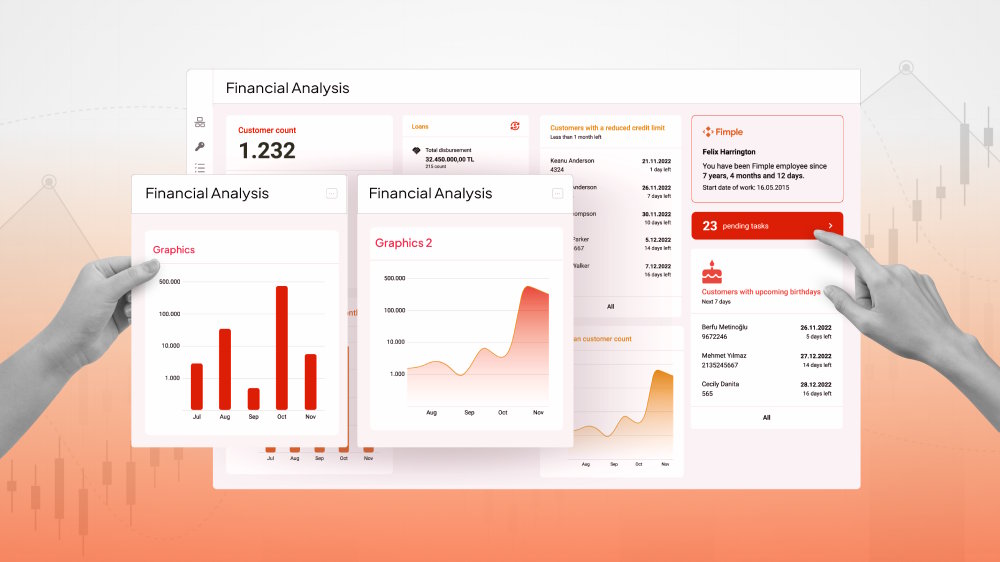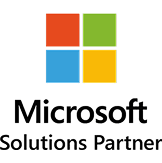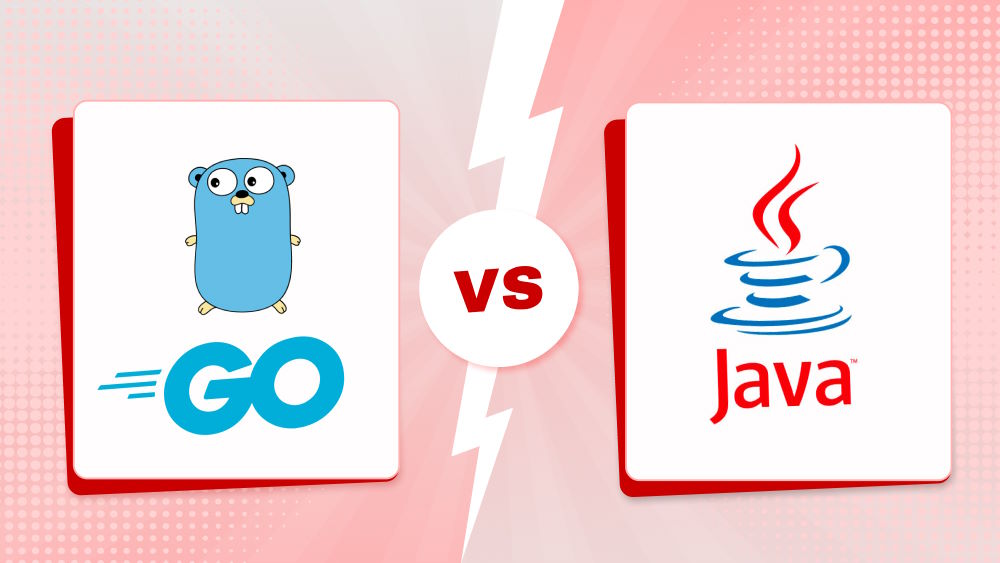
Here Are the 7 Best Golang IDE Editors
If Golang is your programming language of choice, it will be helpful for you to learn about its IDE editors. These tools grant access to features that enhance Go programming. This post will suggest seven popular Golang IDEs, among many other options.
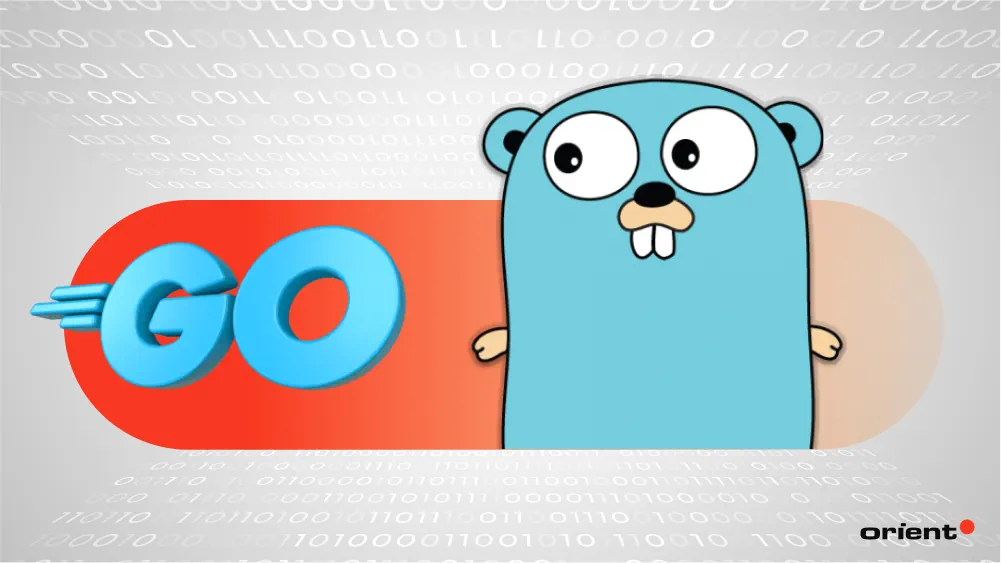
Content Map
More chaptersA Golang IDE, or Integrated Development Environment, is software designed to help Go programmers be more productive and efficient. To achieve these outcomes, an IDE covers many ways to write code for a computer program, such as editing, compiling, and debugging code, into a single application. There are many Golang IDEs to choose from, and knowing which one is right for you can help streamline your software development life cycle.
What is Golang?
Golang, short for Go Programming Language, was developed by Google in 2007 and released as open source on November 10, 2009.
Golang is a statically typed, compiled coding language, where type checking (the process of verifying that data is represented properly in a program) occurs at compile time. This makes it easier for programmers to know what arguments (variables) they should send to a function in order for that function to work correctly. It also assists with early error detection, as the compiler will produce an error upon receiving an incompatible argument.
At Orient Software, we are huge fans of Golang, and we mentioned it as one of the top programming languages of the future.
What is an IDE?
An IDE (Integrated Development Environment) is software that combines multiple programming tools into a single GUI (Graphical User Interface). Such tools may include, but are not limited to, an advanced code editor, debugger, autocomplete function, executable builder, and compiler. Giving developers access to multiple tools in one application can help them produce cleaner code faster, without the hassle of manual configuration and integration.
Most IDEs support multiple programming languages so that developers can maintain multiple codebases and languages on one platform. Examples of multi-language IDEs include Visual Studio Code, Xcode, Android Studio, and Eclipse. There are also IDEs that primarily support one programming language, such as Zend Studio (PHP) and Vim-go (GO).
What are the Six Best Golang IDE Editors?
Below is a detailed breakdown of the seven best editors and IDEs for Go developers. Some of these IDEs support multiple programming languages, but they have specific features to enhance the Golang development process, such as configurable syntax code highlighting to improve search and navigation through color coding.
Vim-go
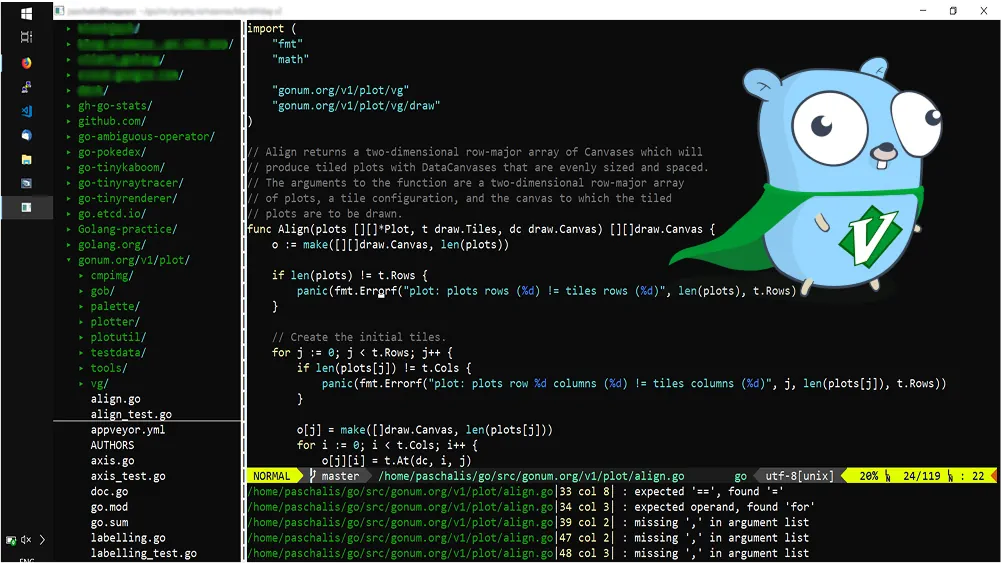
Vim-go is an open-source plugin that adds Golang support to the Vim and Neovim text editors. Once installed, developers can use a wide variety of new features. These include intelligent code completion (similar to autocomplete for Word editors), advanced source analysis tools, linting your code (to catch static errors), and easy import and removal of packages.
Vim-go is also notably lightweight, capable of handling large, complex workloads while using minimal memory and delivering fast loading times.
| Pros | Cons |
|---|---|
| Fast and lightweight | Steep learning curve |
| Highly customizable with plugins and extensions | Requires manual setup and configuration |
| Works in both Vim and Neovim | Hard to remember all of the keyboard-driven commands |
| Multi-language support | No built-in GUI tools |
| Cross-platform support | |
| Ideal for terminal-based development |
Goland
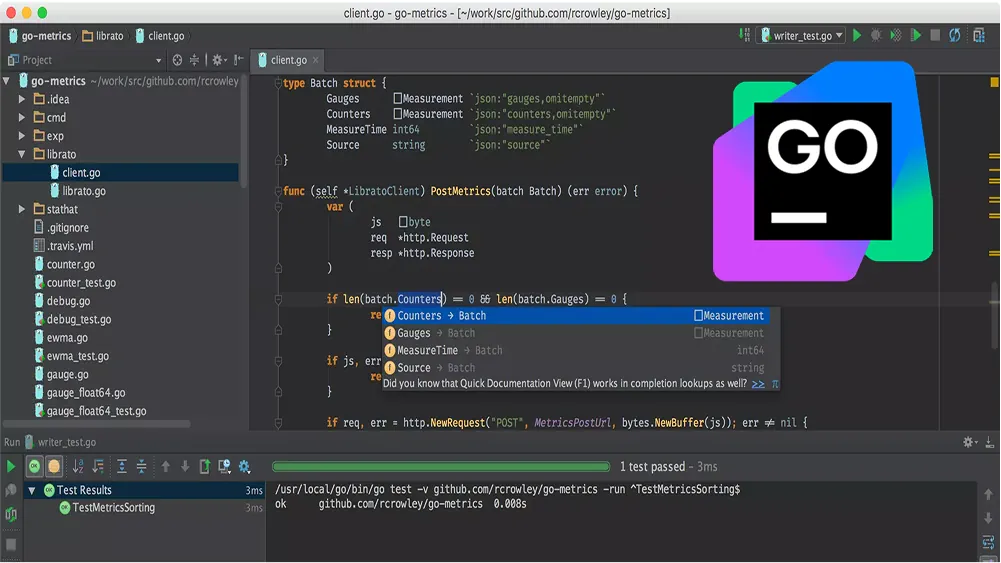
GoLand is a commercial IDE developed and distributed by JetBrains and is one of the most popular editors for Golang development. It assists the Go development process in many ways. You can use it to assess code, suggest recommended code completions, highlight function exit points, and heaps more. It also has dead code detection for identifying and removing, if desired, inexecutable code snippets.
Besides Go, GoLand also supports many other languages, including your preferred programming language, of course. Goland is a commercial product and is available to purchase as a personal license (U.S. $89.00 a first year) and business license (U.S. $199.00 per user).
| Pros | Cons |
|---|---|
| Full-featured IDE made specifically for Golang | Higher cost |
| Cross-platform support | Heavier than minimalist editors |
| Remote development support | |
| Refactoring support | |
| Strong support for web frameworks and APIs | |
| Integrated testing, debugging, and version control |
Visual Studio Code (VS Code)
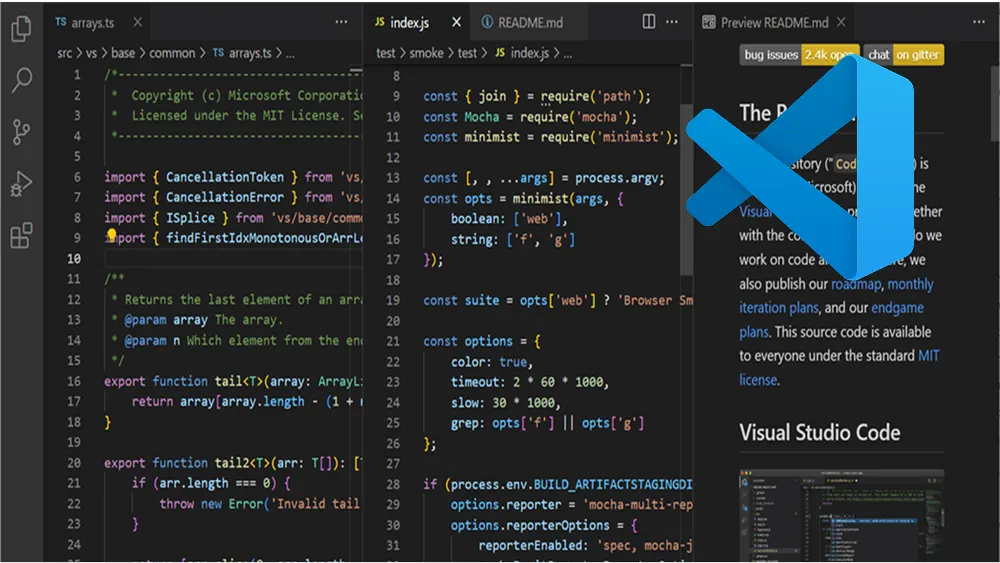
Visual Studio Code is not only a powerful IDE and open-source code editor developed by Microsoft, but also a highly versatile web development tool for full-stack developers. The Golang-specific extensions in Visual Studio Code include semantic syntax highlighting, hover information, symbol search, auto completions, and signature help. The signature help feature is a small pop-up that provides help for whichever function the developer is trying to incorporate into the codebase.
Also, Visual Studio Code has several hotkeys to assist with code navigation, whereby different keyboard combinations can direct developers to different code snippets, open new pop-up windows, and show all implementations when requested.
| Pros | Cons |
|---|---|
| Cross-platform support | Heavier than minimalist editors |
| Free and open-source | The debugging setup can require extra configuration |
| Multi-language support | Require extensions to achieve optimal performance |
| Rich plugin ecosystem | |
| Excellent UI and customization |
IntelliJ IDEA
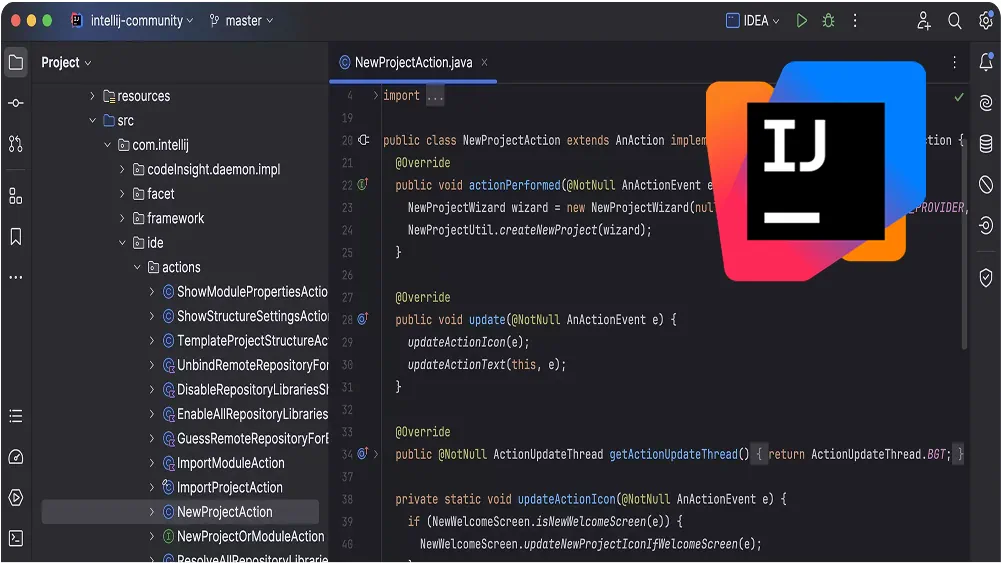
IntelliJ IDEA is another popular IDE developed by JetBrains. Aside from the standard IDE features, such as code completion, code generation, syntax highlighting, inspections, and code refactoring, what makes IntelliJ IDEA stand out is indexing.
Indexing is where the IDE examines the developer’s code, creating a virtual map of proposed methods, objects, classes, and other elements related to their application. In doing this, the IDE is intimately aware of the source code’s details, leading to the act of finding usages and performing smart completion incredibly fast.
| Pros | Cons |
|---|---|
| Good support for Go via plugin | Heavy resource usage |
| Robust refactoring tools | Subscription-based pricing |
| Provide context-aware code completion | Steep learning curve |
| Strong Maven and Git integration | Limited support in the community edition |
| Multi-language support |
LiteIDE
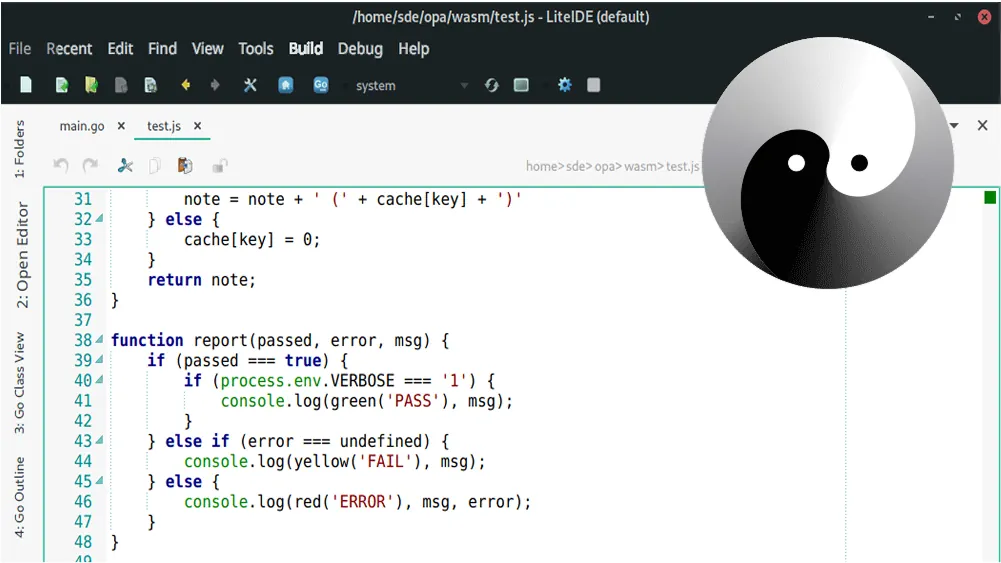
LiteIDE is an open-source, cross-platform IDE that focuses exclusively on Go code. Available for Windows, macOS, and Linux operating systems, LiteIDE makes cross-platform collaboration easy for developers.
LiteIDE features MIME-type management for easy identification of data labels, configurable build commands for creating build specs, and a plug-in system for installing new plugins and enhancing Golang functionality. It is also ad-free and requires no registration or prior installation to use.
| Pros | Cons |
|---|---|
| Built specifically for Go | Outdated UI and user experience |
| Lightweight and fast | Limited documentation and community support |
| Cross-platform support | Fewer integrations and features |
| Easy to set up | Limited plugin ecosystem |
| Simple and easy to learn | |
| Offer GUIs for build, run, and debug tasks |
AWS Cloud9
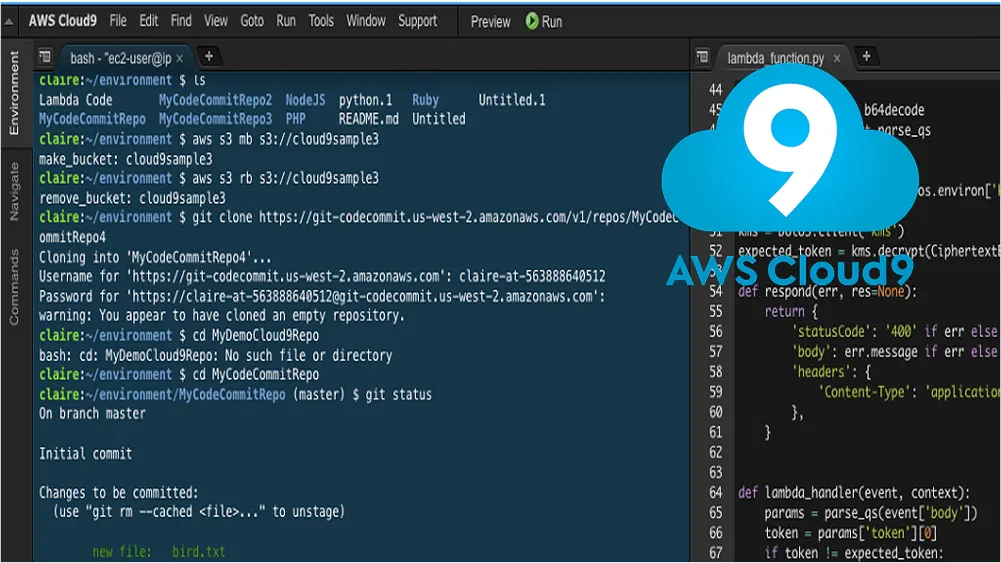
Released by Amazon which runs in your browser, AWS Cloud9 is considered the best cloud IDE in the market. It supports multiple languages like Python, PHP, JavaScript, and of course, Golang. As a cloud-based IDE, developers can work and collaborate on projects at home, in the office, and on the go, wherever lies a stable internet connection.
Real-time collaboration is one of the strongest features of AWS Cloud9. Developers can share their development environment, work together simultaneously, and even chat with one another inside the IDE. Any developers making changes to the code will have their names appear, making it easy to track and monitor changes.
| Pros | Cons |
|---|---|
| Multi-language support | Depend on the internet connection |
| No installation required as a cloud-based IDE | Limited customization options |
| Access from anywhere | Not ideal for offline development |
| Integrates with AWS services | Close new customer access |
| Real-time collaboration |
Sublime Text
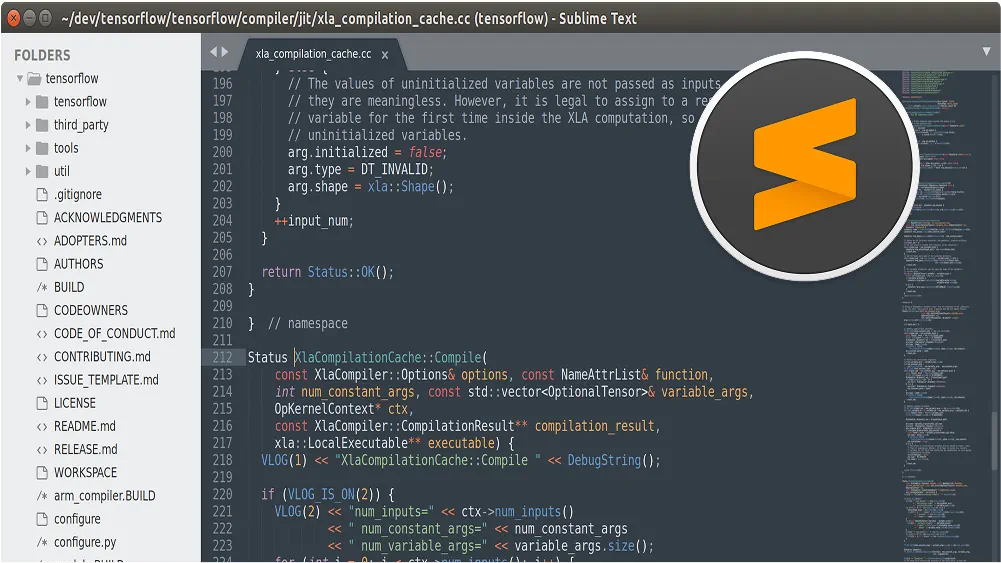
Sublime Text is one of the top Golang IDEs which is widely used by software developers for writing and editing code across multiple programming languages including Java, Python, C++, and Go, etc. Available on Windows, macOS, and Linux with a consistent UI and experience, Sublime Text is known for its customizable and fast performance nature, even with large files.
It offers several Golang plugins and packages, like GoSublime, that allow programmers to add coding capabilities such as build system integration, tags, renaming functionality, and code completion. Although Sublime Text is not a free IDE, it offers users an unlimited trial with occasional reminders to purchase a license.
| Pros | Cons |
|---|---|
| Multi-language support | Lack of debugging capabilities and testing tools |
| Cross-platform support | Require a license after evaluation |
| Lightweight, responsive, and fast | Require additional plugins for some features |
| Extensive customization options | |
| Great for quick edits or script writing | |
| Easy to get started and set up |
Choosing the Right Golang IDE
Hopefully, this breakdown of the seven best IDEs for Golang will help you make the right choice for your project. Whichever platform you pick, it is important that the one you choose is right for your development environment, has the necessary features you need to be more productive, and is compatible with your development requirements.
Ask yourself these questions below for better decision-making:
- Does the IDE fully support the programming language you are using?
- Is the IDE beginner-friendly or more suitable for skilled developers?
- Can the IDE handle large codebases without performance issues?
- Does the IDE provide the features you need?
- Does the IDE work on your operating system (Windows, macOS, Linux)?
- Do you prefer a cloud-based IDE or a local IDE?
- Is the IDE community active and keeping them updated?
- Is the IDE free or paid?
- Are there plugins for the other tools you use?
- How steep is the setup and configuration?
Despite being a relatively young programming language, Golang has become increasingly popular over the years, with the latest research from JetBrains indicating around 1.1 million Go devs worldwide. This means more developers than ever are keen on learning Go or enhancing their Go productivity with new features, which is where the influx of more IDEs can help both parties grow and improve their skill sets.
Learn more about Orient Software’s software development services and experience with Go development and other general technologies.




